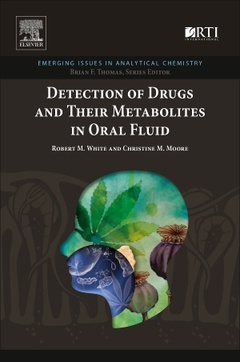Description
Detection of Drugs and Their Metabolites in Oral Fluid
Emerging Issues in Analytical Chemistry Series
Authors: White Robert M., Moore Christine M.
Language: English
Subjects for Detection of Drugs and Their Metabolites in Oral Fluid:
85.00 €
In Print (Delivery period: 14 days).
Add to cart140 p. · 15x22.8 cm · Paperback
Description
/li>Contents
/li>Readership
/li>Biography
/li>Comment
/li>
Detection of Drugs and Their Metabolites in Oral Fluid presents the analytical chemistry methods used for the detection and quantification of drugs and their metabolites in human oral fluid. The authors summarize the state of the science, including its strengths, weaknesses, unmet methodological needs, and cutting-edge trends. This volume covers the salient aspects of oral fluid drug testing, including specimen collection and handling, initial testing, point of collection testing (POCT), specimen validity testing (SVT), and confirmatory and proficiency testing. Analytes discussed include amphetamines, cannabinoids, cocaine, opiates, phencyclidine, cannabimimetics, and miscellaneous drugs.
This practical guide helps users turn knowledge into practice, moving logically from an outline of the problem, to the evaluation of the appropriateness of oral fluid as a test medium, and finally to a consideration of detection methods and their validation and employment.
1. Introduction2. Oral Fluid Pharmacokinetics3. Collection of Oral Fluid4. Point of Collection Testing5. Initial Testing 6. Specimen Validity Testing (SVT) 7. Confirmatory Testing 8. Proficiency Testing9. Individual Analytes, Specimen Handling, Stability, and Other Issues10. Concluding Remarks
Analytical chemists, pharmacologists, medical practitioners involved in drug treatment, addictionologists, clinical trials specialists, regulatory scientists and administrators, public health officials, forensic scientists, toxicologists, and law enforcement
Dr. Christine M. Moore, PhD, DSc, is the Chief Toxicologist, Research for Immunalysis (a part of Abbott), Pomona, CA. She holds a PhD in Forensic Toxicology from the University of Glasgow, Scotland (1989). She is Board Certified in Toxicological Chemistry by the American Board of Clinical Chemistry (DABCC), and is a Fellow of the Royal Society of Chemistry and the American Academy of Forensic Sciences. Dr. Moore is Past President of both the Society of Forensic Toxicologists (SOFT) and the Society of Hair Testing. She is a member of the International Association of Toxicologists (TIAFT), the American Association of Clinical Chemistry (AACC), the Research Society on Alcoholism (RSA), the California Association of Toxicologists (CAT), and the International Council on Alcohol, Drugs and Traffic Safety (ICADTS). Additionally, she is Past-President of the Mid-West Association for Toxicology and Therapeutic Drug Monitoring (MATT) and is past Chair of the Toxicology Section of the American Academy of Forensic Sciences. She serves on the Editorial Board of the Journal of Analytical Toxicology and is a reviewer for several other journals. She has published extensively on the analysis of drugs in biological matrices, including oral fluid, blood, meconium, and hair.
- Compares different collection and testing systems to assist readers involved in clinical or forensic practice in selecting oral fluid as the matrix of choice
- Provides a sound basis for the detection of drugs and their metabolites in oral fluid and the interpretation of both positive and negative
- Places the need, or lack thereof, for specimen validity testing and confirmation testing in context with the purposes of oral fluid testing
- Describes drugs and drug classes that can be tested, along with useful information on a patient/donor’s drug status




